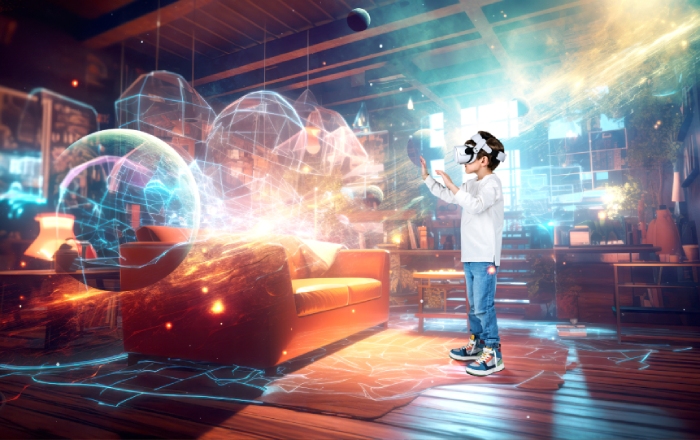The world is talking about the metaverse, and maybe rightfully so. It’s a concept that has gained traction over recent years, with recent reports indicating that the metaverse market could reach between $2 to 4 trillion by 2030. This potential has made everyone sit up and take notice, especially in the education sector. But what’s the likelihood of it entering our classrooms? Please read this blog to get a better understanding of what metaverse is, its challenges, and how it can help digital learning for education.
What Is the Metaverse?
The metaverse refers to a digital environment in which users engage with virtual objects and communicate in a fully immersive setting accessible over the internet. It has the potential to revolutionize education by offering engaging learning experiences that transcend traditional classroom boundaries. Recent advancements in virtual reality (VR) and augmented reality (AR) have made it possible to create highly realistic and interactive virtual worlds for educational purposes.
Within the metaverse, students can explore scientific concepts, delve into historical events, and interact with cultural artifacts in ways that are not feasible in the physical world. Unlike traditional VR experiences, the metaverse emphasizes a service-oriented approach with sustainable material and social significance.
This blog discusses the use of the metaverse in education, providing educators and researchers with a comprehensive understanding of its potential challenges and opportunities.
Can Metaverse Help Digital Learning for Education?
When most people think of the metaverse, they envision a space intended primarily for gaming and entertainment, a perception heavily influenced by pop culture references like the movie Ready Player One. However, the metaverse holds significant potential beyond gaming, particularly in education. In today’s era of reduced attention spans, the immersive nature of the metaverse can captivate students’ interest, thereby enhancing learning outcomes. The following are some of the components of educational metaverse:
- Virtual Reality (VR): VR technology creates immersive, computer-generated experiences that simulate real or imagined environments. Users engage with these environments using VR headsets, allowing them to look around, move, and interact as if they were physically immersed in the given environment. This technology is already being used in fields like medicine, military, and architecture for interactive learning experiences.
- Augmented Reality (AR): AR enhances the user’s perception of the real world by overlaying digital information onto their view. This experience can be accessed through devices like smartphones, tablets, or specialized AR headsets. In education, AR provides contextual information, simulations, and interactive 3D models, making learning more immersive and engaging.
- Mixed Reality (MR): MR combines VR and AR to seamlessly blend real and virtual worlds via specialized headsets that track the user’s movements and positions, creating an immersive experience where virtual and real objects coexist and interact in real-time. MR is used in education, training, remote collaboration, and virtual prototyping.
- 3D Gaming and Extended Reality (XR): These technologies offer immersive experiences that can be used for educational purposes. XR encompasses VR, AR, and MR, providing interactive environments where students can engage with dynamic educational content. This immersion and interactivity can significantly boost learning productivity.
- Holographic Technology: This involves creating 3D images that appear to float in space vbia laser technology. Holographic technology is used in gaming, education, and advertising to create interactive displays and immersive visual experiences. In education, it can create 3D models, simulations, and visual aids to enhance learning.
What Are the Challenges Ahead?
Despite the promising potential, the metaverse in education faces several challenges that must be addressed before realizing its benefits:
- Nascent Stage: The metaverse is still under development. Educational institutions need to adapt their teaching methods to this new paradigm, requiring educators to develop skills in creating 3D environments and fostering collaboration within virtual spaces.
- Accessibility and Cost: Metaverse experiences often rely on expensive VR headsets and powerful computers. This creates an accessibility barrier for students from underprivileged backgrounds. Additionally, developing and maintaining metaverse-based learning environments can strain the resources of schools and universities.
- Data Leaks and Cybercrime: The immersive nature of the metaverse raises concerns about data breaches, fraud, and online harassment. Students, particularly younger ones, might be vulnerable to cybercrime due to their limited online experience.
- Plagiarism and Copyright: The metaverse presents new challenges in protecting intellectual property. Projects and creations by both teachers and students could be easily plagiarized without proper identification systems and security protocols. Blockchain technology and NFTs potentially offer solutions for ensuring traceability and ownership within the metaverse.
- Addiction: The immersive and engaging nature of the metaverse could lead to addiction, particularly among young learners. Thus, finding a balance between virtual and real-world interaction is crucial to prevent social isolation and negative impacts on mental and physical health.
- Ethical Concerns: The global nature of the metaverse raises concerns about potential conflicts based on race, religion, and ideology. Establishing clear rules and regulations within the metaverse will be essential to ensure a safe and inclusive learning environment.
- Real vs. Virtual Disconnect: Spending excessive time in the metaverse could lead to the difficulties of people in the real world and their social anxiety. Thus, educators and parents will need to guide students in understanding the difference between virtual simulations and reality.
While the metaverse offers exciting possibilities for education, carefully considering and addressing these challenges is crucial to ensure a safe, effective, and equitable learning experience for all students.
How MRCC EdTech Can Help
MRCC EdTech, with its comprehensive suite of services and expertise in digital transformation, is well-positioned to support this transition, ensuring that the benefits of the metaverse are fully realized while mitigating associated risks.
- Curriculum Development:
MRCC EdTech specializes in creating engaging and effective educational content. By developing immersive 3D models, images, as well as data and text files tailored to specific curricula, MRCC can enhance the personalized learning experience in the metaverse. These solutions can create engaging and interactive learning environments for students modules that include virtual field trips, historical reenactments, and interactive scientific experiments that make learning more dynamic and memorable.
- Compliance with Standards:
Because ensuring that content meets state, federal, and industry standards is crucial, MRCC EdTech’s compliance expertise ensures that all educational materials not only engage students but also adhere to necessary educational guidelines, thus maintaining educational integrity within the metaverse.
- Ethical Standards:
MRCC EdTech can help establish a comprehensive set of ethical guidelines and regulations for interacting within the metaverse. These guidelines can address ethical concerns like safety, security, identity, and representation to ensure a safe and inclusive virtual learning environment.
- Accessibility and Affordability
To address issues of accessibility and user experience, MRCC EdTech can develop intuitive interfaces and applications that make it easier for students and educators to navigate the metaverse. To overcome the financial barriers associated with metaverse technologies, MRCC EdTech can develop cost-effective VR and AR solutions, making these technologies more accessible to underprivileged students. This includes creating accessible and DEI virtual classrooms that can be adjusted to fit various educational needs and budgets.
MRCC EdTech can transform the potential of the metaverse into a practical, engaging, and inclusive educational reality, a holistic approach that not only addresses the challenges but also maximizes the benefits of immersive learning, setting a new standard for education in the digital age. To know more, please get in touch with MRCC EdTech.




Leave A Reply
Your email address will not be published. Required fields are marked *